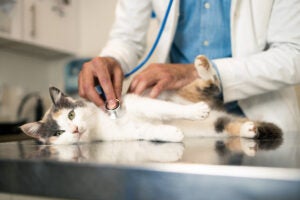My dog needed emergency care and it cost me thousands: Here’s what I learned

I don’t remember much about the morning I had to rush my three year old Pug, Alfie, to the emergency vet, but I do remember the surge of adrenaline, the rush of fear and the desperation to keep him alive.
Fitting the stereotype of the millennial ‘dog parent,’ I was willing to do anything and spend any amount of money to help him. And then I was handed the bill.
America’s 24/7 vet clinic epidemic
When I woke up that morning, I found Alfie unresponsive and stiff with a vacant, glassy look in his eyes. His gait was wobbly at best and he couldn’t keep his balance. Long story short: whatever this was, it wasn’t a pre-existing condition and it came on fast.
I immediately entered panic mode; there was no way to prepare financially or mentally, which I’m sure is what many pet owners go through when faced with similar situations.
Options for 24/7 emergency vet clinics were limited in my area, which seems to be the norm across the nation. There are only 12 to 15 percent of animal hospitals in the nation that provide emergency care are granted with the proper 24-hour accreditations.
Therefore, pet owners – especially those in more rural areas – are often left with very few options. This only increases market demand and costs for the clinics in service across the nation.
The enormous expense of 24/7 care that almost broke me
In the clinic I was surrounded by a chaotic environment of examination tables and cages filled with sleeping animals hooked up to beeping machines.
After multiple tests, a seizure scare, an IV drip and a panel of blood work, the doctor gave me the verdict: Alfie was suffering from acute liver failure due to toxic poisoning and needed to stay overnight. His treatment was to begin immediately and I was given a $1,200 bill to cover a few of the labs and tests.
According to betterpet.com, the average emergency vet bill can cost anywhere from $500 to a whopping $10,000, depending on the severity of the issue and the amount of tests, overnight stays and surgical procedures necessary. I had known this would be expensive, but I couldn’t fathom the bill being over the $3,000 I had saved up for a potential Alfie emergency.
The vet walked over to me with a compassionate look on her face that communicated her displeasure for what she was about to tell me.
Alfie was sitting on my lap, shaking as she told me how much we could be on the hook for – $7,500. This cost was for a predicted one-night stay, not including the $1,200 I had already paid.
I began to panic, unsure of what to do next. They weren’t administering any medication until I paid (I’m sure this was a corporate policy) and I wasn’t going to let my dog die, but I didn’t have a spare eight grand lying around. This is where desperation can begin to sway decision-making skills for pet owners in similar situations.
The problem with “payment plans”
I needed a few moments to figure out what my next move was. As I sifted through the options in my mind, the vet came over to where I was sitting multiple times, asking what I was planning to do with understanding and urgency.
I asked about a payment plan, to which she smiled and responded that they did have a plan. My heart finally stopped beating out of my chest and I began to relax as one of the office staff walked me through the process. The clinic only offered two options: the payment plan or a branded-credit card.
I opted for the plan and assumed the interest rate – if charged – would be lower than on a card. The application process seemed simple enough and the advertisement made it sound very similar to a buy now, pay later loan.
The third-party payment system didn’t require a credit check and I filled out a few general questions about my annual income and the total bill. I was filling it out as quickly as possible and it seemed like an interest-free “pay in four” payment plan as there was no credit check involved.
However, once I was “approved” I was given a few options, all with substantial interest accrual. A 6-month, 12-month and 24-month installment payment plan. I opted for the 6-month plan, as it had a 0 percent APR period and the smallest listed interest accrual.
Alfie was then swiftly carried away and began receiving his treatment and I drove home, dazed and exhausted, not fully comprehending what I had just signed up for or the potential harm it could have caused.
Sky-high rates and the debt cycle trap
Interest rates have been steadily increasing for the past year or so, with the average personal loan rate now at an average of 10.96 percent. That being said, it’s not uncommon to be offered a much higher interest rate than you would have been approved for two years ago.
But there’s a big difference between a normal and a predatorily high interest rate. With online lenders, banks and credit unions, the highest rates go to those with “average” or “poor” scores, with the average rates for borrowers in this credit range stretching from 17.90 percent to 32 percent.
Borrowers on the lower end of the credit spectrum are often aware of the rate caps and through prequalification (if offered) can even know what rate they’re likely to be offered should they apply. However, the difference between a personal loan rate and my “payment plan” rate was that credit didn’t play a factor.
It turns out that the “payment plan” was really a personal – or point-of-sale loan – with an interest rate of nearly 30 percent. There was no credit check, so my score wasn’t factored; it was a bad personal loan with an extremely high interest rate.
The problem with emergency vet payment plans
People are often desperate for any solution when it comes to the wellness of their pets. Most 24/7 emergency clinics are corporately-owned and partner with only a few payment relief companies. Plus, depending on the situation, pet owners may not have the time to shop around and find the best financing option.
The process is often rushed in emergency situations and only once the shock wears off and the beloved pet is back home can the financial planning and damage control begin.
These payment plans – like the one I had – often get consumers into debt cycles; the rates are so high that it’s necessary to take out more debt to pay off older debts. This is particularly common with payday loans (some of which have rates up to 100 percent) and other forms of predatory lending.
The difficulties with navigating payment plan apps
After a few months of making the scheduled payments I dug around and found the rate. Thankfully, the estimated cost was much higher than what we were on the hook for, so the amount we owed – while still sky-high – was marginally more manageable.
After seeing the 26 percent interest rate, I immediately tried to pay off the entire loan and dipped into my emergency fund to avoid the unnecessary thousands in interest accrual. To put it plainly, it was not an intuitive process by any means.
The specific third-party company I used charged a fee for every monthly payment unless you used the ACH method. Of course, my bank didn’t work with them so I was subject to the fee.
What’s more, the company wouldn’t allow me to make one lump sum payment. It only allows customers to make one monthly payment at a time online, increasing the total fee amount. Although it wasn’t advertised, I called the customer support number and thankfully was able to avoid the fees and pay off my full loan with the help of a representative.
What is the solution for emergency care costs?
For those who are working multiple jobs or living paycheck-to-paycheck, a situation like this could be absolutely devastating. While it’s nationally acknowledged that around the clock, emergency care will come with some sort of price tag, the stress and urgency associated with forking over a downpayment (or even total cost) of a car, an entire emergency fund or a year’s worth of savings points to a larger problem.
The harsh reality is that many have had to say an early goodbye to their beloved pets due to the cost of care and the way that the payments are handled. At the end of the day, unless the clinic is private or stand-alone, it’s likely not the veterinary staff who are making the pricing decisions. They’re the ones dedicated to monitoring your pet around-the-clock to ensure they’re safe, healthy and recovering well.
That being said, if you find yourself in a tough financial situation it’s best to ask a staff member to guide you through options and a timeline. It can be easy to feel overwhelmed and angry at the situation, but it’s likely that the staff feel the same as you and it’s important that we remember this when emergencies arise.
Why is veterinary care so expensive?
Emergency clinics will always be more expensive due to the level of care and specializations that the staff members must obtain. At a clinic like Alfie’s, the staff must be properly certified to handle every single emergency situation that could walk through the doors.
“The specialists trained in a specific area of medicine, such as cardiology, internal medicine, oncology, or surgery,” Oakland Veterinary Referral Service’s website reads. “As with medical doctors, specialty veterinarians require years of additional training in their specialized field. They must then take a rigorous test to become board certified in their specialty. This increases their value and their cost.”
When it comes to everyday veterinary care at local animal hospitals, you’ve probably noticed a significant uptick in how much you pay over the years. This is also attributed to the amount of schooling and the extensive training that the staff must go through.
As college prices increase, so does the cost of care. According to the American Veterinary Medical Association (AVMA), the average vet school graduate had $186,430 worth of student debt in 2021. This is up a whopping 17 percent from a decade earlier.
COVID adoption and labor shortages to blame
Inflation can also be to blame for your high bill. According to the federal reserve, vet bills have jumped 10 percent in the past year. Medications, routine labs, supplies and equipment have all been impacted by the turbulent macroeconomic environment.
Karen Leslie, executive director of Pet Fund attributes much of the rising vet costs to labor shortages, inflation and increasing wages as well. “One of the developments we’ve found since COVID is that there was mass retirement and mass quitting of staff,” she says.
“And because there are more animals that have been adopted [since COVID], and that happened at the same time that people quit or retired en-mass, it’s going to take five to seven years to repopulate as people get trained and go through school.”
Inflation, increasing wages also a factor
Leslie also mentions how in light of the mass layoffs and resignations, veterinary institutions have had to scramble to raise wages. “Everybody has had to raise prices to maintain their staff and be able to bring their wages up in terms of equity and in terms of just recognition of the difficulty of their job,” she says.
“This all sort of converged, just creating this perfect storm of then having to recruit aggressively to even get staff who are available and at a higher level.” Leslie adds, noting that this is why vet prices have increased so rapidly.
How pet owners can protect their finances
Here are a few ways to protect your finances while keeping your family pet safe and healthy. Don’t make the same mistakes that I did and be as proactive as possible for emergencies that could arise.
1. Read the fine print
Through this pain-staking process I learned that no matter the situation, it’s always best to read the terms and conditions before signing up for any sort of installment plan.
Even if it is the only or the best option, it’s still vital to understand what you’re signing up for and what it could mean for your finances down the road. If I had never looked into the details just out of sheer curiosity, I never would have known that rate and would have had to fork over more than I originally borrowed by a long-shot.
2. Get pet insurance
Pet insurance is also vital to protecting your finances. Depending on the plan and your deductible, an emergency visit like mine could have a marginal impact rather than a potentially devastating blow to your finances.
Insurance can also provide peace of mind; we can’t watch over our pets all the time and if something were to happen when they’re not in our care or in our line of sight, it’s reassuring to know that at least some of the cost will be covered.
Before signing up, compare lenders, plans and consider the breed of animal you have and their medical history. Some providers won’t see certain animals or breeds, while others may mark up the costs substantially.
It’s also important to choose a plan that will best meet your pet’s needs; if you have an animal prone to sickness, injury or eating foreign objects, make sure the plan covers more than what is considered as a pre-existing condition.
3. Ask questions
No matter the situation, take a few moments to ask the veterinary staff ample questions about the cost of care, the necessity of certain treatments and if you can opt out of any ancillary medications or tests. If there are non-crucial procedures or treatments you can omit, you could be saving thousands of dollars.
Also, ask the staff about the payment options available and if they have a physical flier or informational guide on their payment plans. I’m less likely to miss a detail if I’m looking at it on paper in front of me, so it could have saved me time and stress if they had the information available.
You can also ask the staff if they have a financial assistance department or line you can call. There may be more payment options available within the company or you may be able to negotiate some of your costs. This method isn’t recommended if the payment is needed at the moment and your pet is in urgent need of immediate care as it may take longer to reach a representative or work out an agreement.
You may also like






